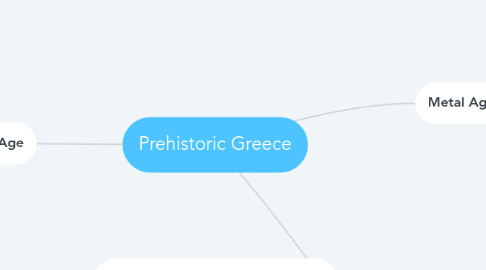
1. Stone Age
1.1. Palaeolithic
1.1.1. 400,000 - 13,000 BC
1.1.2. The earliest evidence of habitation in the Palaeolithic age comes in the form of a skull found in the Petralona Cave in Halkidiki. The Cranium is identified to be a hybrid (mix) between Homo Erectus and Homo Neanderthalensis. It was difficult to date but it was estimated to be about 300.000 to 400.000 years old.
1.1.3. Tools: Many stone tools were found in the greek mainland areas found in sights such as Epirus, Thessaly, Macedonia, and the Peloponnese.
1.2. Mesolithic
1.2.1. 10,000 - 7000 BC
1.2.2. Earliest evidence of burials found in Francthi cave in the Argolid, Greece. Was in 7250 BC
1.2.3. Tools: Many stone tools were found in the greek mainland areas found in sights such as Epirus, Thessaly, Macedonia, and the Peloponnese.
1.3. Neolithic Era (late Stone Age), example in the Aegean Region
1.3.1. 7000 - 3000 BC
1.3.2. Culture:
1.3.2.1. During the neolithic period they started having permanent settlements. They now finally burry the dead with special care. They place gifts on the tomb to accompany the afterlife. The Neolithic settlements in Thessaly which are Sesklo (c. 7000-3200 BC) and Dimini (c. 4800-4500 BC) showed early evidence of sophisticicated social organization, fortifications (in Dimini c. 3400 BC) and constructions of pottery art and megaron houses ( in Sesclo c.5700 BC)
1.3.3. Tools:
1.3.3.1. Advancing the technical knowledge criteria, the head of complex types of tools used for farming, Harvesting, fishing, hunting, cutting up food, treating skin, basketry, weaving. They store products making vessels/contains out of clay, marble, stone. They were Monochrome, Multicoloured. Stone and flint was used for making tools and obsidian/ volcanic glass from the island of melos. Melian obsidian or volcanic glass are very hard material.
1.3.4. Food:
1.3.4.1. The already started raising animas, such as Sheep, Goats, Cattle, Pigs and also dogs. Started to cultivate cereals, pulses and flax.
1.3.5. Economy:
2. Prehistory is a period between the use of stone tools which is around 3.3 million years ago until the first ever writing systems. The earliest writing systems appeared around 5.300 years ago. The end of each prehistoric period for every country is different. It is different because every country has different times on having their writing systems. In Greece the prehistoric period was from 400,000 BC until 1100 BC.
3. Metal Age
3.1. Bronze Age Major advances in social, economic and technological areas making Greece the hub of activity in the Mediterranean
3.1.1. 3300 - 1100 BC
3.1.2. Cycladic Era, example is the Island of IOS in the Aegean Sea
3.1.2.1. 3300 - 2000 BC
3.1.2.2. Shelter : Lived in a sophisticated community consisting of 35 buildings with approximately 200 people. Their houses are 2 stories high. The community is built on very fertile piece of land. Now they have a sophisticated community. Their houses are some big and some small, it shows social order. The hill that was built was made in a circular design. The hill's view is the harbour of the IOS. Their house is made of slabs of grant put on top of each other, dirt to insulate the walls. Roofs are from wooden, local trees. The 2 story houses contains people living on top and storage of grains in the bottom.
3.1.2.3. Food :They raised goats, sheeps and pigs. They also started farming seeds, wheat, Fruit and lentils. They have started to process food from wheat and grind them, making flour. They have a circular area to grind wheat by getting animals to step and stomp off the wheat.
3.1.2.4. Economy : They started to perform trade between islands.
3.1.2.5. They found artefacts from the Cycladic Era such as the Frying Pan and Cycladic Idol (largest known Cycladic Sculpture)
3.1.3. Minoan Era, example of santorini. Town of Aktorini, Island of Crete
3.1.3.1. 2600 - 1200 BC
3.1.3.2. The Minoan Civilisation existed from 2600 - 1200 BC on the island of Crete. The Minoans were considered to be the first advanced civilisation of Eu Shelter: In the Minoan era they have a settlement and they live in a community. The place got demolished by the eruption of the Thera volcano. The houses there look more sophisticated. The stores look like bricks. The society is already ordered. They have sophisticated and toilet system and they have a indoor toilet. There are no human remains left and they evacuated in an orderly managed way. Minoans are considered to be the first advanced civilization of Europe,
3.1.3.3. Food:
3.1.3.4. Economy:They were primarily a mercantile people engaged in extensive overseas trade throughout the mediterranean region.
3.1.3.5. Tools:
3.1.4. Helladic era, on the Greek mainland
3.1.4.1. 2800 - 1600 BC
3.1.4.2. The early Helladic period saw the improvement of settlements near the sea toward the north side of Greece. The started to have different locations on where to live and one of them is the hilltops. The society was ruled by leaders like kings or lords known as wanax. The society evolved and became the Mycenaean civilisation, which would dominate the later Helladic period.
3.1.5. Mycenaean or late Helladic also in mainland Greece
3.1.5.1. 1600 BC-1100 BC
3.1.5.2. Culture: Mycenaeans buried their nobles in beehive tombs (tholoi), large circular burial chambers with high vaulted roof and straight entry passage lined with stone. They often buried daggers or some other form of military equipment with the decreased. The nobility were often buried gold masks, tiaras, armour and jewelled weapons. Mycenaeans were buried in a sitting position, and some of the nobility underwent mummification. Mycenaean is also called the "Age of Heroes" because it is the source of the mythological heroes and epics like Hercules, the Iliad and the odyssey.

